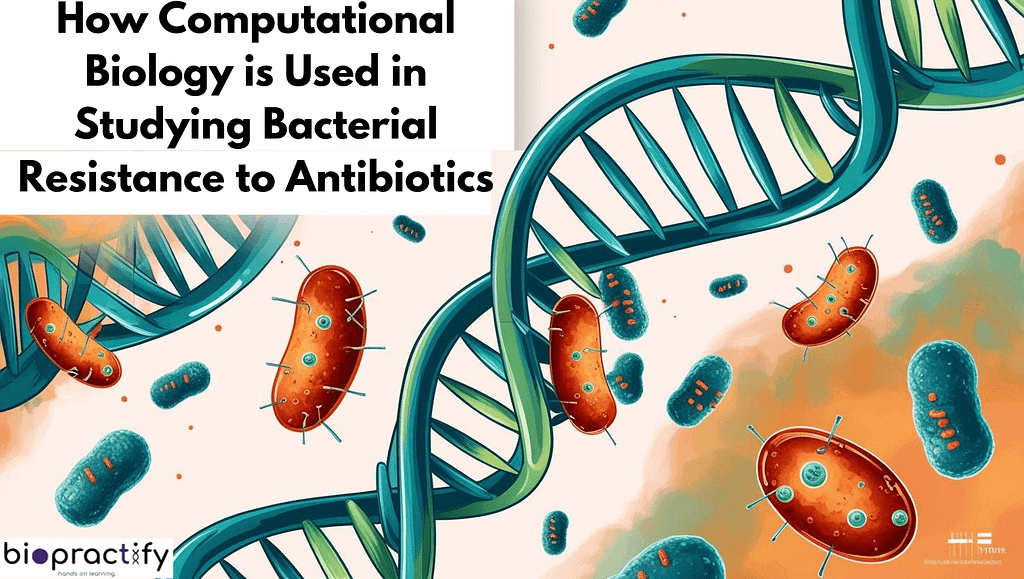Antibiotic resistance is a growing global threat, making it harder to treat bacterial infections. How computational biology is used in studying bacterial resistance to antibiotics is a crucial area of research that helps scientists understand and combat this problem. In this blog, we’ll explore the role of computational biology in tackling antibiotic resistance.

Understanding Bacterial Resistance to Antibiotics
Computational biology uses advanced algorithms, simulations, and data analysis to study how bacteria develop resistance to antibiotics. Scientists analyze genetic mutations and bacterial responses to antibiotics, which helps in designing more effective treatments.
Bacteria develop resistance to antibiotics through different mechanisms, such as:
- Mutation: Bacteria change their DNA to survive antibiotics.
- Gene Transfer: Resistant bacteria can share their defense mechanisms with other bacteria.
- Efflux Pumps: Some bacteria develop pumps to remove antibiotics from their cells.
To tackle this, scientists use computational biology, which applies computer science, machine learning, and bioinformatics to study bacteria at the genetic level.
How Computational Biology is Used in Studying Bacterial Resistance to Antibiotics
Computational biology helps in many ways, including:
1. Analyzing Bacterial Genomes
Genome sequencing is one of the most powerful tools in computational biology. By sequencing bacterial DNA, researchers can:
- Develop targeted treatments to overcome resistance..
- Identify resistance genes in bacteria.
- Track the evolution of antibiotic-resistant strains.
2. Predicting Drug Resistance Using AI and Machine Learning
Artificial Intelligence (AI) and machine learning help researchers:
- Analyze vast amounts of bacterial data quickly.
- Predict which antibiotics may stop working in the future.
- Identify patterns in how bacteria develop resistance.
3. Molecular Docking for Drug Discovery and Development
Computational biology speeds up the process of discovering new antibiotics. Researchers use:
- Molecular modeling to design drugs before testing them in labs.
- Computer simulations to test drug interactions with bacteria.
- Databases to compare potential antibiotics and choose the best one.
This reduces the time and cost needed to create effective treatments.
4. Understanding How Resistance Spreads
Scientists use computational models to track the spread of resistant bacteria in hospitals, water sources, and the environment. This helps in:
- Predicting outbreaks.
- Improving infection control measures.
- Creating better public health policies.
The Future of Antibiotic Resistance Research
The use of computational biology in studying bacterial resistance to antibiotics is transforming the way scientists approach antibiotic resistance. With AI-driven tools, big data, and bioinformatics, researchers are getting closer to developing sustainable antibiotic solutions.
Learn more about genome sequencing and antibiotic resistance.
Read about machine learning in drug resistance prediction.
Read more: Role of Quantum Computing in Bioinformatics
Researchers worldwide are working together to stay ahead of antibiotic-resistant bacteria. By using computational biology, we have a powerful tool to protect human health for generations to come.
Final Thoughts
Understanding how computational biology is used in studying bacterial resistance to antibiotics is crucial for fighting this global issue. From analyzing bacterial genomes to developing new drugs, computational biology helps scientists stay one step ahead of resistant bacteria.
As technology improves, we will see even faster, smarter, and more effective solutions to antibiotic resistance. The battle against superbugs is tough, but with computational biology, we have hope.


Leave a Reply